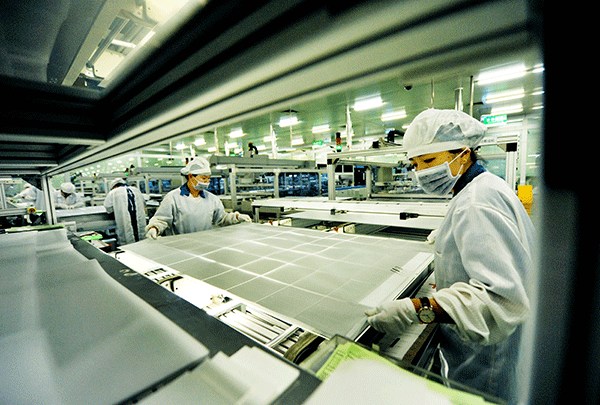
Workers at a plant of JinkoSolar in Jiangxi province produce solar polycrystalline silicon sheets.(ZHUO ZHONGWEI/CHINA DAILY)
The 13th Five-Year Plan will see major efforts to adjust China's energy mix as the nation restructures its economic model.
Slowing economic growth and shrinking energy consumption mean that meeting the government's ambitious goal for renewable energy consumption will remain a tough challenge as China's energy sector embarks on a restructuring program in the coming five years.
Top leaders gathered in Beijing this week at a session of the Communist Party of China Central Committee to formulate proposals for the 13th Five-Year Plan (2016-20). Energy strategy will come under intense scrutiny because of the sector's close connections with the economy and the environment.
China has pledged to increase the share of non-fossil fuels in the primary energy mix to 15 percent by 2020, and to 20 percent by 2030.
Experts say the program for the next five years is very clear; the general thrusts will be controlling coal consumption, stabilizing the use of oil and gas, increasing the use of wind and solar power, and speeding up energy-pricing reform to support the structural transition.
A target has been set to limit energy use to the equivalent of the annual use of 4.8 billion metric tons of standard coal by 2020, the State Council said in November.
Taking slower economic growth and weaker energy demand into account, the target is not as daunting as when it was set, according to Lin Boqiang, director of the China Center for Energy Economics Research at Xiamen University in Fujian province.
Theoretically, the government could impose restrictions, particularly on the use of coal, to press ahead with the transformation of the economic model, but that would be a difficult strategy to accomplish.
"Coal remains a competitive and convenient choice in practice, particularly at a time when the industry is facing excess capacity," Lin said.
Energy use surged 45 percent in the seven years running up to 2013, as a result of the country's rapid economic growth. That significantly affected global energy demand, because China accounted for 23 percent of the world's total energy use.
Major coal consumers-industries such as power, steel, chemicals and building materials-are facing overcapacity and more stringent environmental standards, factors that are dragging down coal consumption.
Although last year saw the first decline in China's coal output after 15 years of consecutive growth, coal still accounted for 66 percent of the country's energy consumption.
Both wind and solar power have enjoyed rapid expansion in recent years. According to a recent medium-term report on renewable energy from the International Energy Agency, China accounts for 40 percent of global renewable capacity growth.


















































